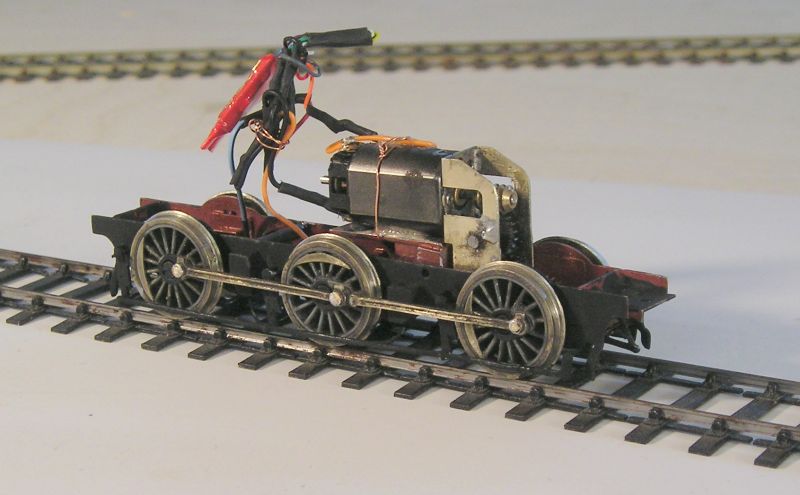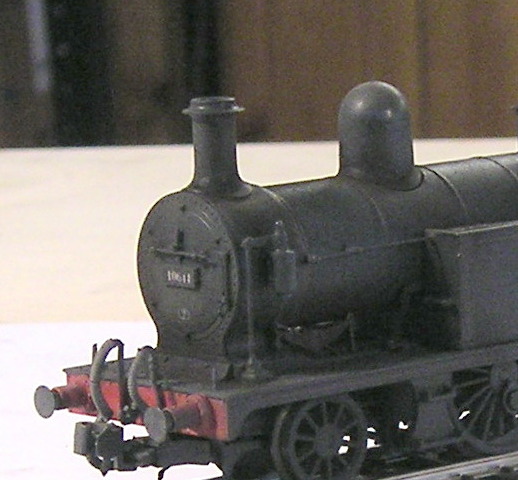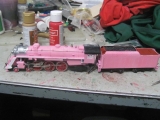Comet Chassis
Posted
#220643
(In Topic #12020)
Inactive Member
I am building a GWR Small Branch and because I live in the USA have been out of British Modelling for 40 years I was all set to buy a Loco when I received 3 Locos by Bachman to install DCC and was a little disappointed with the Waddly Duck running . I was thinking about replacing the Chassis with Comet Models Chassis (more room for sound as well) If I do that can I buy the Bodies and Tenders separately.
Or maybe the newer models don't waddle?.
David
A Yorkshireman in the USA.
Posted
Full Member
First question David, are the Bachmann locos US or UK? I'm aware that Bachmann US don't have the best rep.
Thinking back to the very early days of Bachmann Branchline (UK) I can't recall any of their locos that waddled to the extent that I noticed. Mind you this is subjective.
The only RTR loco that I can recall that waddled in an unacceptable way was the 00 Works L&Y 0-6-0ST. I'm in the process of replacing that chassis with one from London Road Models. You can see more on this in my thread.
What locos are you specifically troubled with? Comet do a broad range of chassis kits and packs to suit almost any prototype and make up into a very good model.

This is a Comet Jinty chassis I made in EM. I've abandoned EM for now so it's an orphan. Gearbox is High Level 80:1 - IMO the best.
I would only go to the trouble of replacing the chassis of a modern RTR loco (post 2000) if something failed catastrophically.
I have seen separate bodies and tenders here and there. Manufacturers don't sell these as separate items. Comet did do a "kit" for an LMS 8F which used Hornby's body and Comet chassis packs. Perhaps the best way to do this is to look for a second hand non-runner.
John
 Last edit: by Brossard
Last edit: by Brossard
John
Posted
Full Member
Not clear from the post - they are for your layout?
Bachmann Europe's renditions of GWR 0-6-0's and 2-6-2's perform much better with DCC than DC, unless the latter is with a modern controller. Both have enough room under the hood for an N-scale decoder and a speaker in the bunker. If sugar cubes are used you can get a couple of them in. One of my 2-6-2's has 2 regular-sized speakers in, one in the cab and one in the boiler/smoke-box, and a full-sized Digitrax decoder. Lot of butchery and hackery though.
I've watched the real things mooching along at Didcot and on the East Somerset - they waddle at low speed. The GWR never did get the balance weights right. Bachmann actually got it spot on.
If they are early Bachmann models from when they took over Mainline it's a different story - split chassis and no room for anything, and a mechanism with inbuilt slop to accommodate toy-train track.
Comet kits come as separate chassis for the engine and where appropriate the tender, as many modelers choose to do the engine and leave the tender alone. SE Finecast and Allan Gibson Workshop are 2 other chassis/frame suppliers. Allan Gibson Workshop currently have 3 kits in stock (850 class, 1076 class and 4600) that you will not find anywhere else.
Nigel
.
©Nigel C. Phillips
Posted
Inactive Member
I have not actually bought a Loco yet I guess I am basing my comments on the Two LNER UK Bachman Locos I have had sent to me to be DCC,d and they may well be older.
Small GWR Branch any Loco Recomendations?.
 Last edit: by Matador
Last edit: by Matador
Posted
Full Member
I'll let others make further recommendations since I'm not current with GWR stuff.
John
John
Posted
Legacy Member
Oh, and the 14xx wouldn't be too happy if it didn't have an Autocoach to boss around !
Allan.
 Last edit: by allan downes
Last edit: by allan downes
Posted
Full Member
Posted
Legacy Member
A couple of my favourites are on the way, 14XX 0-4-2T from DJ Models and 23XX Dean Goods 0-6-0 from Oxford."
John
This will be one build I will just have to follow John.
Can I expect plenty of arghs ?
Allan
Posted
Full Member
The 14xx and 23xx as mentioned by David are two great BLT locos which should be with us soon and available to pre-order from Hattons now. The 0-4-2 is very well suited to a GWR branch, particularly coupled to an autotrailer. However, no GWR branch should be without a pannier of 45xx, both available from Bachmann and are superb runners which easily accept chips.
There is also a new inexpensive Collet 0-6-0 tender goods engine coming from Bachman which, depending on the era you wish to model, is the natural replacement for the 23xx Dean goods.
Have fun and looking forward to hearing more of your plans.
Bill
At 6'4'', Bill is a tall chap, then again, when horizontal he is rather long and people often used to trip over him! . . . and so a nickname was born :)
Posted
Full Member
[user=565]Brossard[/user] wrote:A couple of my favourites are on the way, 14XX 0-4-2T from DJ Models and 23XX Dean Goods 0-6-0 from Oxford."
John
This will be one build I will just have to follow John.
Can I expect plenty of arghs ?
Allan
Wait – what? I'm not building these, I don't even do GWR :roll: I do have a soft spot for them having had the Airfix and mainline versions respectively a lot of years ago. I recall building Comet and Perserverance chassis for these which transformed the running.
John
John
 Last edit: by Brossard
Last edit: by Brossard
John
Posted
Full Member
GWR branchline engines? Depends on what era you want to model and how close to the prototype you want to be.
Most branchlines had weight restrictions which limited what would run. This was usually "unclassified" or at best "yellow", with axle loading's of 14 and 16 tons respectively (long tons). If you're modeling a prototype, check the color restriction, if you do a freelance one it's up to you.
The 14xx series could be found everywhere, "uncolored" classification. Built from 1932 on to replace the 517 class of tank engines dating from 1868-1885, they were numbered in the 48xx and 58xx class until 1946 when 4800-4874 were renumbered into the 1400-1474 class (the 14xx). The 48xx class had auto-gear and ATC fitted, the 58xx class as built did not.
The 2200 class "Collett Goods" is an example of a good idea in principle. Built from 1930 on to replace the Armstrong and Dean Goods it had a "yellow" weight classification. Both the Armstrong and Dean Goods were unclassified, and could go anywhere, whereas the Collett Goods was barred from many lightly built branchlines (such as Lampton, Highworth and Faringdon).
Which means a bucolic 1930's branchline would have 517 tanks, Metro tanks or 4800 tanks pulling and pushing an autotrailer or a B-set, not a 1400; an Armstrong or Dean Goods for the freights, and from 1933 on the occasional diesel railcar (which came under the carriage, not locomotive department). This would be the "flying banana" one, not the later Swindon-built version (modeled by Lima/Hornby). Wait for Dapol or get a "kit" from Worsely Works in brass.
The 0-6-0 tanks are a complicated and convoluted story, check the literature. Normally classified into shunting and light freight (5700 for example) and light passenger duties (5400, 6400/7400) depending on the wheel diameter. "Yellow" classification for most of them. Many of the photos of a 5700 pulling a passenger coach are from BR days, I suspect they were not used very much for this under the GWR. BR also allocated "yellow" 0-6-0's to unclassified branchlines.
Only light Prairies (4400, unclassified, 4500/4575, yellow) were normally found on branchlines, the large Prairies were Blue or Red classification.
The books by Brian Haresnape and Alec Swain are useful for the classification details, as is Russell. The RCTS book on six-coupled tank engines is also useful for the details of the early six-coupled engines (but decidedly lacking on Prairie details).
One minor issue we're all facing is the autogear that would be used for pull-push operations was supplied by Mainly Trains. If anybody knows of another supplier for the brass kit please post.
My stock list for a GWR branchline? Two 4400's with autogear (or one 4400 and one 517 or Metro tank), an Armstrong outside frame Goods or Dean Goods, a Collett goods, a 5700, a light Prairie (square tanks, unclassified), and a "flying banana" diesel railcar (for the evening "mystery" jaunts that the GWR ran when they were introduced). Two autotrailers and an older B-set for the passengers. Plus around 20 freight vans/wagons and 2 "Toads". Which would put it firmly in the early- to mid-1930's with a yellow route classification. Branchlines didn't often get the latest except on a running-in turn, they got the hand-me-downs, often one major failure away from the scrap heap. Lot of kit building, and a nice mix of old and modern (for the 1930's).
All of the 4800 series at Hattons are 14xx's (old ones and the forthcoming DJ ones) so that limits them from 1946 up to nationalization - 2 years. Renumber them to the 4800 or 5800 series and that gives you 1932-1946. Go for 1935-1939 and you can use just the lettering, not the GWR circular totem. Introduced in 1934 but stock still can be seen in 1939 with the old style lettering only, the totem would have been applied at a major overhaul. Devil's in the details.
If you are going for details such as in the preceding paragraph, check what is available RTR as it may not fit exactly in with what you want to model. Otherwise, ignore it and run what you fancy.
Nigel
©Nigel C. Phillips
Posted
Full Member
Re the vacuum regulator gear for pull push trains. If you can find a decent photo or even drawing, it can be made from bits and pieces you might have lying around.
As here: 
and here:

 Last edit: by Brossard
Last edit: by Brossard
John
Posted
Full Member
Nigel
Edit added: There's a bit more to it than the pipes (one for steam, one for the vacuum brakes). The GWR used mechanical linkages, not vacuum, for the auto-gear. And at both ends for when the engine was sandwiched between 2 autocoaches.The part from Mainly Trains is the bracket that goes under the buffer beam.

This is the simplified version. It's up to the modeler to put linkages on. Plus most of the 4800/1400 class had ATC shoes underneath as well. Gets pretty busy underneath the buffer beams.
©Nigel C. Phillips
Posted
Full Member
Posted
Inactive Member
Well I took the 3 models apart yesterday and they are indeed split older chassis so I can move forward and confidently buy RTR New. I must say the Customer sent a new Hornby loco that runs superbly but that only arrived this morning wish it had been sent with the other three then this post would not have been needed. Thank you for all the Push Pull info also.
David
A Yorkshireman in the USA.
Posted
Full Member
I suspected as much David. They could be waddling because they suffer from the Bachmann split chassis disease. The driver axles are connected by a plastic sleeve. This sleeve deteriorates over time and the wheels loosen and lose quartering. IMO your customer is wasting his money having these converted to DCC. Better I think to buy the same loco new.
If I had some sort of emotional attachment to the locos you mention, they would be candidates for a Comet chassis. However, by the time you've bought the chassis, wheels and motor/GB, you will have spent almost as much or even more than the same RTR model - and you still have to build it
Pretty much all the manufacturers locos designed after 2000 are good runners. We tend to denigrate "made in China" but those Hornby locos "made in England" before 2000 were always poor in my view.
John
 Last edit: by Brossard
Last edit: by Brossard
John
Posted
Full Member
Covered in another posting to you, but John's right - waddling normally means split plastic axle holders that allow the stub axles to move around (especially the one with the gear). It's a common problem in older Bachmann models. There is no cure, only replacements, which may or may not fit as newer models have different shaped stub axles (been there, done that, too many times). They need a complete gear/axle/wheel replacement.
If the axle holders are split it's not worth doing a DCC conversion unless it's repaired.
Nigel
©Nigel C. Phillips
1 guest and 0 members have just viewed this.


